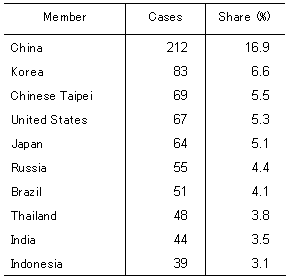Ever since embarking on market-opening reforms, the increase in exports has been a major factor supporting China's high growth rate, and this trend has become all the more conspicuous with China's entry into the World Trade Organization. However, as the share of Chinese products on the global market rises and the country's trade imbalance with major countries rapidly expands, friction with trading partners is also escalating. In the short term, China must work to eliminate such frictions through bilateral negotiations and the WTO, but in the long term, it is essential for it to transform its economy into one in which growth is led by domestic demand.
A protectionist trade policy that quickly comes to mind is the restriction of imports by implementing such steps as safeguards and antidumping measures. Although the WTO supports free trade in principle, it condones as exceptions these two actions as being temporary emergency measures. However, in reality they have become protectionist tools commonly used the world over.
Safeguards allow for relief measures such as import restrictions and tariff hikes in the event a domestic industry is seriously injured or is threatened with serious injury due to unforeseeable circumstances. In June 2000, South Korea raised its tariff on garlic imports from China, while in April 2001 Japan introduced provisional safeguard measures on three agricultural products (stone leeks, shiitake mushrooms and tatami rushes) from China. Also, because the safeguard measures on steel products introduced by the United States on March 5, 2002 were certain to adversely affect domestic industry, China filed a case with the WTO on March 26 as a means of self-defense.
Meanwhile, antidumping actions may be taken when there is material damage or a threat of damage to a domestic industry due to the dumping of imported products sold at lower-than-usual prices. China has been the most frequent target of antidumping measures. Antidumping investigations initiated against China alone totaled 312 between 1995 and 2002, and the number of cases in which action was actually taken came to 212 during the same period. ( table ) The products targeted are wide-ranging, from agricultural goods such as garlic and apples to steel pipes and electric appliances such as television sets.
Furthermore, non-tariff barriers in the form of tightening regulations and standards also serve as protectionist tools for individual countries. The WTO allows countries to set their own standards so long as they are consistent with WTO agreements and are not arbitrary or discriminatory. Triggered by the issue of residual pesticides in frozen spinach imported from China that came to light in May 2002, Japan revised the Food Sanitation Law. The revisions made it possible to impose a comprehensive ban on the import of specific food products that were produced in a country that is strongly suspected of violating the law. They may be used to justify import restrictions in the name of consumer protection and domestic regulations. Here, China argued that Japan's standard for residual pesticides for frozen spinach was itself unreasonable, but exports effectively stopped as the Japanese government asked firms to refrain from importing the product from China.
In addition to individual sectors, the rise in China's trade imbalance as a whole is intensifying frictions with importing countries. Japan, the U.S. and Europe are all seeing surges in their trade deficit vis-a-vis China, and calls are mounting for the yuan's revaluation. However, as we can see from the experience of the bilateral trade friction between Japan and the U.S., although the trade balance is in the short term affected by exchange rates, in the long-term it is determined by the balance between investment and savings in the countries involved. To reduce its trade surplus, China needs to correct its reliance on exports through the expansion of domestic demand.
Table: Increasing U.S. trade deficit with China, Japan, and the rest of the world

(Source)WTO


